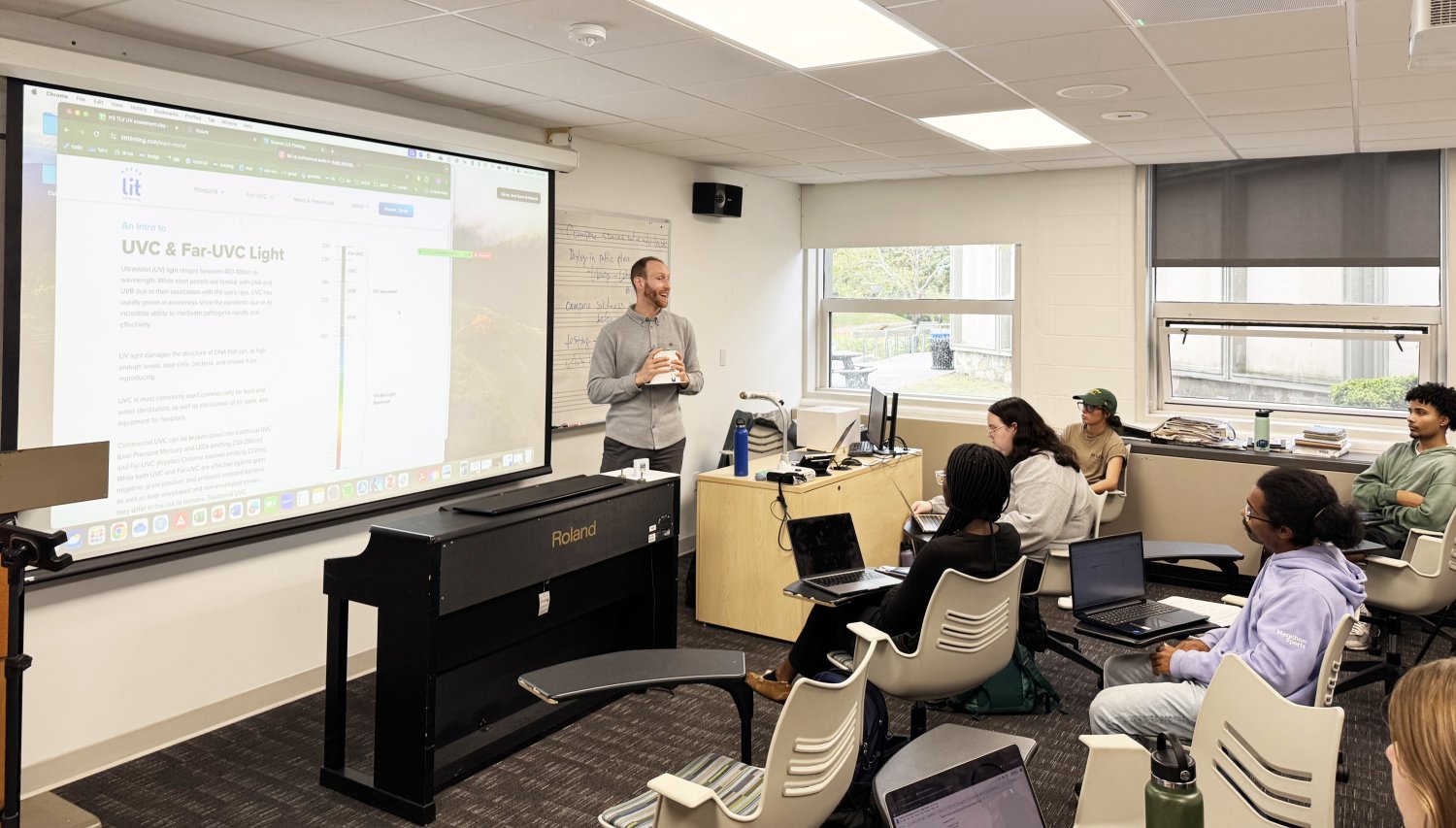Study on Germicidal Ultraviolet Technology Aims to Inform Public Health Application
Assistant Professor of Public Health P. Jacob Bueno de Mesquita receives grant to research GUV effectiveness in reducing viral transmission.

BRISTOL, R.I. – Roger Williams University Assistant Professor of Public Health P. Jacob Bueno de Mesquita has received a grant to study the effect of germicidal ultraviolet (GUV) light technology on reducing airborne pathogens associated with causing infections like the flu and COVID-19.
Through the Rhode Island IDeA Network of Biomedical Research Excellence (RI-INBRE) award, a National Institutes of Health grant, Bueno de Mesquita and student-researchers working in his Human Health and Harmony Lab (H3) will conduct a year-long study quantifying the extent of the great effectiveness and remarkable safety profile of GUV on reducing viral transmission and respiratory infections in a real-world setting. The grant enabled H3 to acquire a special type of extra-safe GUV called far-UVC, made by Lit Thinking, and install it in a classroom and at the RWU Health Center. According to Bueno de Mesquita, the safety profile of the far-UVC technology enables its use in cleaning air in the breathing zone, which also facilitates direct measurement of human and viral exposure proposed by H3.
“A major environmental health problem facing society today is the lack of adoption of key strategies to prevent viral spreading and enable normal societal interaction despite ongoing waves of COVID-19, seasonal epidemics, and emerging pandemic threats,” said Bueno de Mesquita, an environmental health scientist and epidemiologist with expertise in quantifying airborne viral transmission risk and promoting population health. “The project offers a number of opportunities for cross-disciplinary student training, while positioning the university to make real contributions to the scientific discourse on a topic of urgent importance to public health.”
GUV alters the structure of viral and bacterial DNA making them unable to infect, Bueno de Mesquita explained. GUV is most used for commercial food and water sterilization, and Bueno de Mesquita argues that it is not being used in nearly enough healthcare, restaurant, and public transit settings, and other public settings.

Bueno de Mesquita’s student researchers will use a few methods of quantifying the effectiveness and safety of far-UVC on reducing airborne pathogens within the classroom and health care exam room environments where the technology is deployed at RWU. Students use a spectroradiometer to measure the level of energy coming off the GUV lamps at different points in the room. The higher the level of radiance, he said, the more energy there is that is reaching that site in the room. Students taking Bueno de Mesquita’s Systems of Human Health and Disease Public Health course are invited to wear colorimetric dosimetry strips, which turn darker blue when exposed to more GUV energy, giving a time-weighted sense of exposure during normal use of the room.
Scientists at Columbia pioneered this method using it in dental clinic and piano bar settings. Bueno de Mesquita explained that the method builds on only a few prior studies that measure exposure and effectiveness, assuming people are not static over the course of an eight-hour day exposure (the status quo for regulating the use of the technology), and may eventually support unleashing of the full potential of GUV technology and broader adoption of the technology to help mitigate pandemics, seasonal epidemics, and colds.
The H3 team, Bueno de Mesquita’s team of public health and other interested students, will use the data to do risk assessment to visualize and communicate the extent of the infection control provided by the far-UVC. The group hopes to continue to partner with Public Relations and Graphic Design programs on campus to help communicate findings in the most compelling ways to educate both the broader population and key legislators about the power and safety of this key infection control strategy.
“This real-world research is training students for biomedical science, public health, and health communication careers,” Bueno de Mesquita said.
GUV technology has been around for nearly a century and has been demonstrated to be highly effective in mitigating viral transmission, but it hasn’t been widely adopted in use, according to Bueno de Mesquita. While their research intends to add new data showcasing this as a proven method, it also aims to communicate the opportunity for greater use of GUV more widely and to expand the conversation on this technology within the public health field and the greater public’s understanding.
“You can consider this as a demonstration study. We collect our own data so we can have something to talk about with respect to the extent of what is known to be a remarkably effective and safe technology,” he said. “The hope is that this student-generated data provides solid scientific evidence that could then help launch a communication, design, and messaging campaign to get out how important this technology is for mitigating all sorts of viral transmissions.”